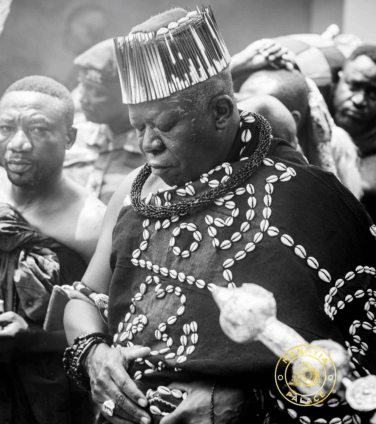On the second day of the Asantehemaa’s burial rites, Asanteman stood still in reverence as Otumfuo Osei Tutu II, the Asantehene, appeared clothed in mourning regalia that spoke louder than words ever could.
Draped in a black cloth adorned with cowries, he embodied not just personal grief, but the sorrow of an entire kingdom. In Asante tradition, black is the ultimate color of bereavement—a solemn mark of respect for the departed. Yet this garment carried more than symbolism of mourning. The cowries stitched across the fabric, once used as currency, evoked wealth, spirituality, and a sacred connection to the ancestors. In this setting, they stood as a measure of the inestimable value of the late queen mother, whose life and service to the Golden Stool remain beyond reckoning.
Crowning his presence was a headpiece edged with cowries and rising with vertical adornments, a striking reminder of his dual role: sovereign ruler and chief mourner. His appearance was both majestic and heavy with sorrow, embodying the weight of cultural continuity in the face of irreparable loss.
In Akan culture, the passing of a queen mother is not merely the loss of a family figure but a rupture at the very heart of the stool—the spiritual foundation of the kingdom. Thus, the Asantehene’s attire became more than clothing; it transformed into a sacred canvas. Each cowry stitched into the cloth was a thread of continuity, a declaration that even in death, the Asantehemaa’s spirit remains interwoven with the destiny of her people.
The bowed head of the king, his solemn expression, and the silent eloquence of his regalia captured both the depth of grief and the resilience of tradition. What he wore was not simply fabric, but mourning made visible—a cultural language of reverence, sorrow, and enduring strength.












